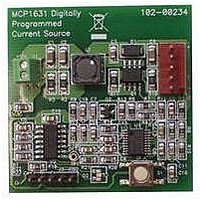MCP1631RD-MCC1 Microchip Technology, MCP1631RD-MCC1 Datasheet - Page 63

MCP1631RD-MCC1
Manufacturer Part Number
MCP1631RD-MCC1
Description
REFERENCE DESIGN FOR MCP1631HV
Manufacturer
Microchip Technology
Type
Battery Managementr
Datasheets
1.MCP1631VHVT-330EST.pdf
(34 pages)
2.MCP1631HV-330EST.pdf
(54 pages)
3.MCP1631RD-MCC2.pdf
(20 pages)
4.MCP1631RD-MCC2.pdf
(328 pages)
5.MCP1631RD-MCC1.pdf
(28 pages)
Specifications of MCP1631RD-MCC1
Main Purpose
Power Management, Battery Charger
Embedded
Yes, MCU, 8-Bit
Utilized Ic / Part
MCP1631HV, PIC16F883
Primary Attributes
1 ~ 2 Cell- Li-Ion, 1 ~ 4 Cell- NiCd/NiMH
Secondary Attributes
Status LEDs
Supported Devices
MCP1631HV, PIC16F883 Device Type
Tool / Board Applications
Power Management-Battery Management
Development Tool Type
Reference Design
Input Voltage
5.5 V to 16 V
Product
Power Management Modules
Mcu Supported Families
MCP1631HV/PIC16F883 Family
Silicon Manufacturer
Microchip
Silicon Core Number
MCP1631HV
Kit Application Type
Reference Design
Application Sub Type
Battery Charger
Kit Contents
Board Only
Lead Free Status / RoHS Status
Lead free / RoHS Compliant
For Use With/related Products
MCP1631HV, PIC16F883
Lead Free Status / RoHS Status
Lead free / RoHS Compliant
- MCP1631VHVT-330EST PDF datasheet
- MCP1631HV-330EST PDF datasheet #2
- MCP1631RD-MCC2 PDF datasheet #3
- MCP1631RD-MCC2 PDF datasheet #4
- MCP1631RD-MCC1 PDF datasheet #5
- Current page: 63 of 328
- Download datasheet (6Mb)
4.0
4.1
The oscillator module has a wide variety of clock
sources and selection features that allow it to be used
in a wide range of applications while maximizing perfor-
mance and minimizing power consumption. Figure 4-1
illustrates a block diagram of the oscillator module.
Clock sources can be configured from external
oscillators, quartz crystal resonators, ceramic resonators
and Resistor-Capacitor (RC) circuits. In addition, the
system clock source can be configured from one of two
internal oscillators, with a choice of speeds selectable via
software. Additional clock features include:
• Selectable system clock source between external
• Two-Speed Start-up mode, which minimizes
• Fail-Safe Clock Monitor (FSCM) designed to
FIGURE 4-1:
© 2009 Microchip Technology Inc.
or internal via software.
latency between external oscillator start-up and
code execution.
detect a failure of the external clock source (LP,
XT, HS, EC or RC modes) and switch
automatically to the internal oscillator.
OSC2
OSC1
OSCILLATOR MODULE (WITH
FAIL-SAFE CLOCK MONITOR)
Overview
External Oscillator
Internal Oscillator
HFINTOSC
LFINTOSC
31 kHz
8 MHz
SIMPLIFIED PIC
Sleep
®
MCU CLOCK SOURCE BLOCK DIAGRAM
PIC16F882/883/884/886/887
500 kHz
250 kHz
125 kHz
31 kHz
8 MHz
4 MHz
2 MHz
1 MHz
(OSCCON Register)
IRCF<2:0>
111
110
101
100
011
010
001
000
The oscillator module can be configured in one of eight
clock modes.
1.
2.
3.
4.
5.
6.
7.
8.
Clock Source modes are configured by the FOSC<2:0>
bits in the Configuration Word Register 1 (CONFIG1).
The internal clock can be generated from two internal
oscillators. The HFINTOSC is a calibrated high-
frequency oscillator. The LFINTOSC is an uncalibrated
low-frequency oscillator.
LP, XT, HS, RC, RCIO, EC
EC – External clock with I/O on OSC2/CLKOUT.
LP – 32 kHz Low-Power Crystal mode.
XT – Medium Gain Crystal or Ceramic Resonator
Oscillator mode.
HS – High Gain Crystal or Ceramic Resonator
mode.
RC – External Resistor-Capacitor (RC) with
F
RCIO – External Resistor-Capacitor (RC) with I/
O on OSC2/CLKOUT.
INTOSC – Internal oscillator with F
on OSC2 and I/O on OSC1/CLKIN.
INTOSCIO – Internal oscillator with I/O on
OSC1/CLKIN and OSC2/CLKOUT.
OSC
/4 output on OSC2/CLKOUT.
Power-up Timer (PWRT)
Watchdog Timer (WDT)
Fail-Safe Clock Monitor (FSCM)
INTOSC
(Configuration Word Register 1)
(OSCCON Register)
FOSC<2:0>
SCS<0>
(CPU and Peripherals)
DS41291F-page 61
System Clock
OSC
/4 output
Related parts for MCP1631RD-MCC1
Image
Part Number
Description
Manufacturer
Datasheet
Request
R

Part Number:
Description:
REFERENCE DESIGN MCP1631HV
Manufacturer:
Microchip Technology
Datasheet:

Part Number:
Description:
REF DES BATT CHARG OR LED DRIVER
Manufacturer:
Microchip Technology
Datasheet:

Part Number:
Description:
Manufacturer:
Microchip Technology Inc.
Datasheet:

Part Number:
Description:
Manufacturer:
Microchip Technology Inc.
Datasheet:

Part Number:
Description:
Manufacturer:
Microchip Technology Inc.
Datasheet:

Part Number:
Description:
Manufacturer:
Microchip Technology Inc.
Datasheet:

Part Number:
Description:
Manufacturer:
Microchip Technology Inc.
Datasheet:

Part Number:
Description:
Manufacturer:
Microchip Technology Inc.
Datasheet:

Part Number:
Description:
Manufacturer:
Microchip Technology Inc.
Datasheet:

Part Number:
Description:
Manufacturer:
Microchip Technology Inc.
Datasheet:










